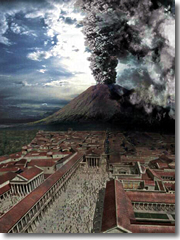- Places
- Plans
- Itineraries
- Experiences

The Last Days of Pompeii. (Image courtesy of Crew Creative, LTD and the Discovery Channel.)From a base in Naples or resorty Sorrento, you can day-trip to visit one of the most destructive forces in western history, Mt. Vesuvius, and the ancient Roman cities it destroyed—and through a quirk of fate, preserved for the ages, ghost towns of antiquity where frescoed villas, echoing bath halls, and racy brothels stand by silent temples, courtyard homes, and bakeries where the millstones still stand at the ready in the back, gathering weeds.
A short train ride from Naples will take you to Pompeii and Herculaneum, two cities completely buried by the volcano's wrath in AD 79, frozen in time and offering an unparalleled glimpse into daily life almost 2,000 years ago.
To cycle back even further in time, head to southern Campania, where you can wander amid the columns of some of the most intact Greek temples in the world in the forgotten 5th-century BC colony of Paestum.
Unlike the commercial port of Pompeii, which was covered in ash, Herculaneum got slammed by hot mud and rocks when Vesuvius blew its top in 79 AD. That means excavations here have been more difficult and slower going, but in many ways this ancient ghost town is even better preserved, giving an even better glimpse into life in the Roman Empire than is Pompeii.
It's also far, far less crowded. For every 7.5 people clogging Pompeii's ancient streets, there's just one wandering around Herculaneum, according to the official 2003 figures. The difference is even more noticeable during summer high season, when the ratio is 10 to 1. Conveniently, Ercolano is a stop on the same Circumvesuviana train from Naples that services Pompeii:
Mt. Vesuvius and the ancient Roman cities it buried in AD 79 (most famously Pompeii and Herculaneum) lie on the southern curve of the Bay of Naples, south of the city. The best way to see them is by using the private commuter rail line Circumvesuviana (tel. 081-772-2444, www.vesuviana.it), a clattering old suburban rail line out to Sorrento.
It services Herculaneum (Ercolano-Scavi" in Italian; 17 min), Vesuvius (same stop), Pompei (36 min.), and Sorrento (60 min.), with trains roughly every 20 minutes.

Follow signs for the "Circumvesuviana" regional commuter line, which runs underneath Naples' train station.Circumvesuviana trains leave from a special station underneath Naples' main "Stazione Centrale" train station on Piazza Garibaldi, though finding it is a bit tricky.
If you're arriving by train, head toward the station's main exit, but just before you get there, look to the left for stairs leading down. (If you're already in Naples: when you arrive at the station—fist firmly clenched around your wallet, as this is Italy's pickpocket central—enter the main doors and walk toward the tracks, but look for the stairs down to the Circumvesuviana about halfway before you get there.)
Follow "Circumvesuviana" signs, but partway along the hall stop at the ticket windows on your left.
Note: Several different commuter lines use the same platform, so ask around to be sure the train is bound for Sorrento (or Ercolano, or Pompei) before stepping on board. (Over the years, I've probably stopped at least 50 fellow tourists from getting on the wrong train—and those were just the people standing next to me on the platform.)
Beware of pickpockets every step of the way (the Naples train station is the black hole of Italian pickpockets, and they love to work the tourist-packed Circumvesuviana train as well).
Share this page
Search ReidsItaly.com
GUIDED TOURS From NAPLES
Tours that cover most Vesuvius region sights (Pompeii, Herculaneum, Mt. Vesuvius, etc.)